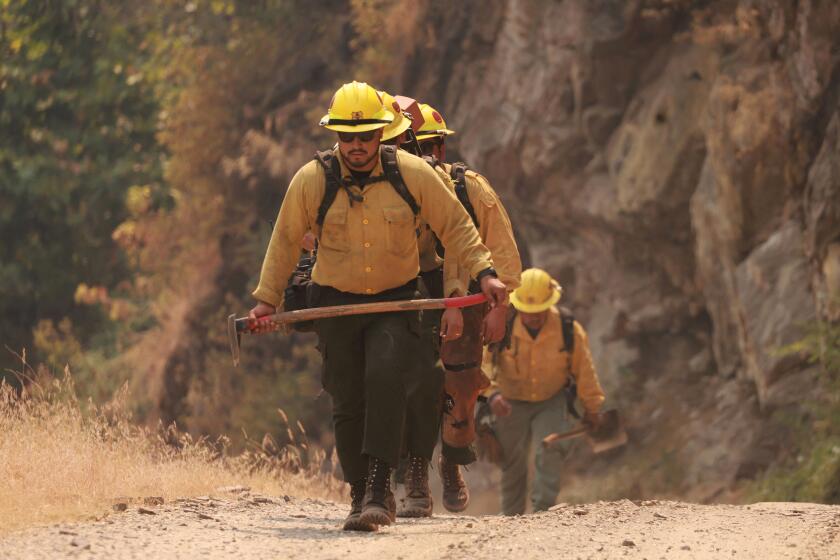
- Share via
Exposure to wildfire smoke increases the odds of being diagnosed with dementia even more than exposure to other forms of air pollution, according to a landmark study of more than 1.2 million Californians. The study — released Monday at the Alzheimer’s Assn. International Conference in Philadelphia — is the largest and most comprehensive review of the impact of wildfire smoke on brain health to date, according to its authors.
“I was expecting for us to see an association between wildfire smoke exposure and dementia,” said study author Dr. Holly Elser, an epidemiologist and resident physician in neurology at the University of Pennsylvania. “But the fact we see so much stronger of an association for wildfire as compared to non-wildfire smoke exposure was kind of surprising.”
Aggressive and impactful reporting on climate change, the environment, health and science.
The findings have big health implications, particularly in Western states, where air pollution produced by wildfires now accounts for up to half of all fine-particle pollution — a figure that’s been trending upward as wildfires grow larger and more intense due to climate change and legacies of fire suppression and industrial logging that have altered the composition of many Western forests.
The researchers looked at a type of particulate-matter pollution called PM2.5. These particles are 30 times smaller than the width of a human hair — tiny enough to penetrate deeply into the lungs and cross over into the bloodstream, where they can cause inflammation. Exposure has been shown to raise the risk of dementia and a host of other conditions, including heart disease, asthma and low birth weight.
“We increasingly see that PM2.5 is tied to virtually every health outcome we look at,” said study author Joan Casey, associate professor of public health at the University of Washington.
Elser, Casey and fellow researchers analyzed the health records of more than 1.2 million Kaiser Permanente Southern California members 60 or older between 2009 and 2019. None had been diagnosed with dementia at the beginning of the study.
They estimated each person’s exposure to PM2.5 based on their census tract of residence and then separated that into wildfire and non-wildfire pollution using air quality monitoring data, satellite imagery and machine learning techniques.
They then looked at how many participants were eventually diagnosed with dementia. Unlike past studies, the researchers were able to determine this using patients’ full electronic health records, rather than relying on hospitalizations as a proxy for such diagnoses.
Looking at participants’ average wildfire PM2.5 exposure over three years, the researchers found a 21% increase in the odds of a dementia diagnosis for each increase of 1 microgram of particulate matter per cubic meter of air. When it came to non-wildfire PM 2.5 exposure, they documented a 3% increased risk of dementia diagnoses for each increase of 3 micrograms of particulate matter per cubic meter of air.
For the record:
10:31 a.m. July 29, 2024A previous version of this article included an outdated percentage increase, 23%, for the odds of a dementia diagnosis. The researchers have updated the finding to 21%.
“That’s what it comes down to, is what’s so different about wildfire smoke?” Casey said.
A prolonged heat wave across much of the western U.S. is challenging wildland firefighters, with an uptick in heat-related illnesses reported in California.
More research is needed to learn exactly what that is. Possibilities include the fact that wildfire particles are produced at higher temperatures, contain a greater concentration of toxic chemicals and are, on average, smaller than PM2.5 from other sources.
These ultrafine particles can translocate from people’s noses into their brains via the olfactory bulb, Casey said.
“Normally the brain is protected by the blood-brain barrier, but here there’s actually a direct route for ultrafine particles to get into the brain and possibly cause some of the problems that we’re seeing in folks living with dementia,” she said.
The way in which people are exposed to wildfire smoke also differs from other types of fine-particle pollution, the researchers said. Background or ambient fine-particle pollution levels are usually relatively constant in a given place over time. But wildfire particulate matter tends to fluctuate wildly, resulting in more exposure over shorter periods of time, which may overwhelm the body’s defenses.
Of some 5,500 abstracts submitted to the Alzheimer’s Assn. International Conference, this one stood out due to its novelty, importance and impact, said Dr. Claire Sexton, senior director of scientific programs and outreach for the Alzheimer’s Assn.
“There have been other studies looking at different types of pollution, but this was unique in terms of the extent and the way in which it was able to do these analyses,” she said.
The researchers found the effects to be stronger on Asian, Black and Latino people, as well as those living in high-poverty areas. The most heavily impacted group was one that researchers classified as “other” because it didn’t contain enough people to differentiate further, Casey said. That group included Indigenous people, Pacific Islanders and people whose race was unknown.
“So these disparities are playing out again, as we unfortunately often see with environmental exposures,” she said. “But the level at which we observed it here was fairly striking.”
Casey believes those disparities are due to differential exposure based on where populations are located, noting that her previous research has shown that Indigenous people in California have by far the highest levels of wildfire particulate exposure. Other factors could include poorer housing quality, lack of access to air filtration devices, jobs that prevent people from staying indoors during wildfire events and disparate responses to the same amount of pollution due to preexisting hypertension or diabetes, she said.
“All those things are driven by social determinants of health,” she said. “The fact that we need to allocate additional resources to these people and places to protect health and to try to reduce health disparities going forward is really important.”
The researchers did not differentiate between dementia subtypes like Alzheimer’s, the most common form, because they relied on diagnostic codes rather than using brain imaging or postmortem studies. That’s important to know — and a key area for future study — because in order to best protect people, clinicians need to have an understanding of what’s underpinning the relationship between wildfire smoke and different dementia subtypes, Elser said.
California’s prisons are uniquely unprepared for climate change because of remote locations, aging infrastructure and overcrowding, experts say.
Still, the study is notable for its massive sample size and careful approach, taking into account sociodemographics like comorbidities and census tract poverty, said Rachel Whitmer, the director of the UC Davis Alzheimer’s Disease Research Center who was not involved in the research.
The prevalence of dementia is on the rise as the baby boomer generation ages, but environmental factors may also be contributing to the increase, she said.
Research like this lays the groundwork for future studies, she said.
“With the increase in wildfires, this is a really important question and I think they did a really rigorous job in exploring it,” she said.
Levels of PM2.5 had been declining since the Clean Air Act took effect in 1970. But wildfires have reversed those trends in California, undercutting efforts to reduce emissions. In recent years, wildfire smoke has also affected the Midwest and East Coast. In 2023, smoke from Canadian wildfires blanketed the Atlantic seaboard, triggering air quality alerts and forcing the cancellation of outdoor events.
“It’s a big problem in places where wildfires are endemic,” Elser said. “And I worry that as we continue to experience increasingly frequent wildfire events, this could affect more people over a larger geographical distribution, more of the time.”










